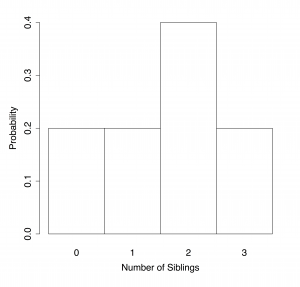4.2 Probability Distribution of a Discrete Variable
The probability distribution of a discrete random variable [latex]X[/latex] lists all possible values and their corresponding probabilities. In general, the probability distribution of a discrete variable is given in a table with two rows or two columns: one row (column) for the possible values [latex]x[/latex] and the other row (column) for the corresponding probability of taking each value [latex]P(X = x)[/latex]. A probability distribution has two important properties:
Key Fact: Two Important Properties of Probability Distribution
- [latex]0 \leq P(X=x) \leq 1[/latex]
- [latex]\sum_{\text{all possible } x} P(X=x) = 1[/latex]
Example: Probability Distribution of a Discrete Variable
- Consider the chance experiment of flipping a balanced coin twice; the sample space is S = {HH, HT, TT, TH}. Let the random variable X = # of tails. Determine the probability distribution of X.
- First, determine the possible values of [latex]X[/latex]. If we flip a coin twice, we might observe zero tail (HH), one tail (HT, TH), and two tails (TT). Therefore, possible values are [latex]x = 0, 1, 2[/latex].
- Next, determine the probabilities [latex]P(X=x), x = 0,1, 2[/latex]. Since the coin is balanced, it follows that [latex]P(H)=P(T)=0.5[/latex]. Moreover, the two flips are independent, so the special multiplication rule applies. Thus,
- [latex]P(X=0)=P(HH)=P(H) \times P(H)=0.5 \times 0.5=0.25[/latex].
- [latex]P(X=1)= P(HT \text{ or }TH)=P(HT)+P(TH)=0.25+0.25=0.5[/latex].
- [latex]P(X=2)=P(TT)=0.25[/latex].
Therefore, the probability distribution of X is
Table 4.1: Probability Distribution of X=# of Heads
[latex]x[/latex] 0 1 2 [latex]P(X=x)[/latex] 0.25 0.5 0.25 Note that the sum of the probabilities is one. That is
[latex]\begin{align*} \sum P(X=x) &= P(X=0) + P(X=1) + P(X=2) \\ &= 0.25 + 0.5 + 0.25 = 1. \end{align*}[/latex]
- A population consists of five students: Mark has no siblings, John has one sibling, both Rebecca and Sarah have two siblings, and Mary has three. Randomly pick one student and let [latex]X[/latex] be the number of siblings the student has. Determine the probability distribution of [latex]X[/latex].
- First, observe that the possible values of [latex]X[/latex] are [latex]x=0, 1, 2, 3[/latex]
- Next, determine the probabilities [latex]P(X=x), x=0, 1, 2, 3[/latex]. One student has no siblings, two students have two siblings, and one student has three siblings. Thus,
- [latex]P(X=0) = \frac{f}{N} = \frac{1}{5} = 0.2[/latex].
- [latex]P(X=1) = \frac{f}{N} = \frac{1}{5} = 0.2[/latex].
- [latex]P(X=2) = \frac{f}{N} = \frac{2}{5} = 0.4[/latex].
- [latex]P(X=3) = \frac{f}{N} = \frac{1}{5} = 0.2[/latex].
The probability distribution of X is
Table 4.2: Probability Distribution of X=# of Siblings
| [latex]x[/latex] | 0 | 1 | 2 | 3 |
| [latex]P(X=x)[/latex] | 0.2 | 0.2 | 0.4 | 0.2 |
Note that the sum of the probabilities is one. That is
[latex]\begin{align*}\sum P(X=x) &= P(X=0)+P(X=1)+P(X=2)+P(X=3)\\ &= 0.2+0.2+0.4+0.2=1. \end{align*}[/latex]
A probability distribution can also be represented as a histogram. Every possible value should have a separate bar for a discrete random variable.


